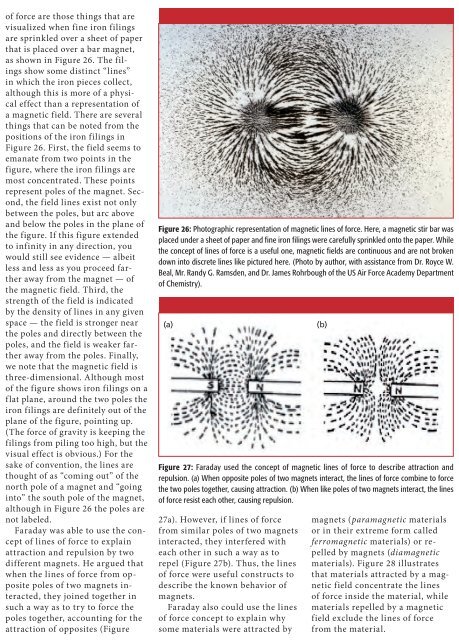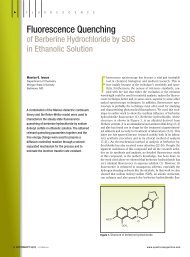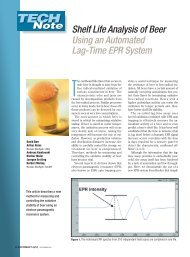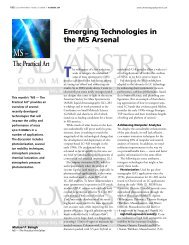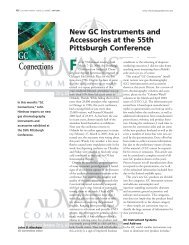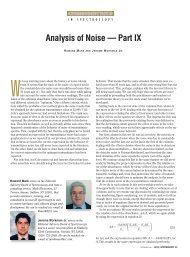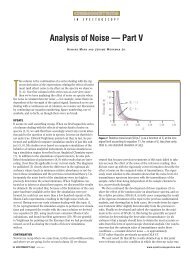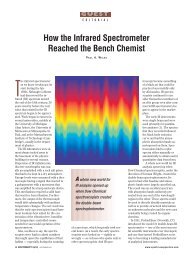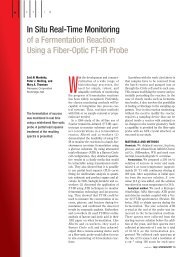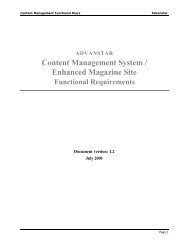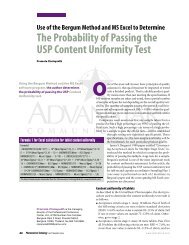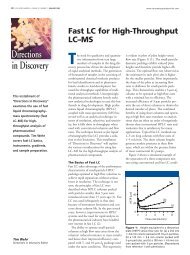2012 Corporate Capabilities - Spectroscopy
2012 Corporate Capabilities - Spectroscopy
2012 Corporate Capabilities - Spectroscopy
You also want an ePaper? Increase the reach of your titles
YUMPU automatically turns print PDFs into web optimized ePapers that Google loves.
www.spectroscopyonline.com<br />
December 2011 <strong>Spectroscopy</strong> 26(12) 11<br />
of force are those things that are<br />
visualized when fine iron filings<br />
are sprinkled over a sheet of paper<br />
that is placed over a bar magnet,<br />
as shown in Figure 26. The filings<br />
show some distinct “lines”<br />
in which the iron pieces collect,<br />
although this is more of a physical<br />
effect than a representation of<br />
a magnetic field. There are several<br />
things that can be noted from the<br />
positions of the iron filings in<br />
Figure 26. First, the field seems to<br />
emanate from two points in the<br />
figure, where the iron filings are<br />
most concentrated. These points<br />
represent poles of the magnet. Second,<br />
the field lines exist not only<br />
between the poles, but arc above<br />
and below the poles in the plane of<br />
the figure. If this figure extended<br />
to infinity in any direction, you<br />
would still see evidence — albeit<br />
less and less as you proceed farther<br />
away from the magnet — of<br />
the magnetic field. Third, the<br />
strength of the field is indicated<br />
by the density of lines in any given<br />
space — the field is stronger near<br />
the poles and directly between the<br />
poles, and the field is weaker farther<br />
away from the poles. Finally,<br />
we note that the magnetic field is<br />
three-dimensional. Although most<br />
of the figure shows iron filings on a<br />
flat plane, around the two poles the<br />
iron filings are definitely out of the<br />
plane of the figure, pointing up.<br />
(The force of gravity is keeping the<br />
filings from piling too high, but the<br />
visual effect is obvious.) For the<br />
sake of convention, the lines are<br />
thought of as “coming out” of the<br />
north pole of a magnet and “going<br />
into” the south pole of the magnet,<br />
although in Figure 26 the poles are<br />
not labeled.<br />
Faraday was able to use the concept<br />
of lines of force to explain<br />
attraction and repulsion by two<br />
different magnets. He argued that<br />
when the lines of force from opposite<br />
poles of two magnets interacted,<br />
they joined together in<br />
such a way as to try to force the<br />
poles together, accounting for the<br />
attraction of opposites (Figure<br />
Figure 26: Photographic representation of magnetic lines of force. Here, a magnetic stir bar was<br />
placed under a sheet of paper and fine iron filings were carefully sprinkled onto the paper. While<br />
the concept of lines of force is a useful one, magnetic fields are continuous and are not broken<br />
down into discrete lines like pictured here. (Photo by author, with assistance from Dr. Royce W.<br />
Beal, Mr. Randy G. Ramsden, and Dr. James Rohrbough of the US Air Force Academy Department<br />
of Chemistry).<br />
(a)<br />
Figure 27: Faraday used the concept of magnetic lines of force to describe attraction and<br />
repulsion. (a) When opposite poles of two magnets interact, the lines of force combine to force<br />
the two poles together, causing attraction. (b) When like poles of two magnets interact, the lines<br />
of force resist each other, causing repulsion.<br />
27a). However, if lines of force<br />
from similar poles of two magnets<br />
interacted, they interfered with<br />
each other in such a way as to<br />
repel (Figure 27b). Thus, the lines<br />
of force were useful constructs to<br />
describe the known behavior of<br />
magnets.<br />
Faraday also could use the lines<br />
of force concept to explain why<br />
some materials were attracted by<br />
(b)<br />
magnets (paramagnetic materials<br />
or in their extreme form called<br />
ferromagnetic materials) or repelled<br />
by magnets (diamagnetic<br />
materials). Figure 28 illustrates<br />
that materials attracted by a magnetic<br />
field concentrate the lines<br />
of force inside the material, while<br />
materials repelled by a magnetic<br />
field exclude the lines of force<br />
from the material.


